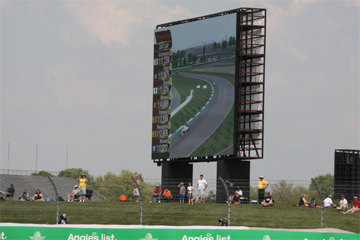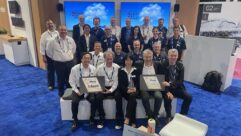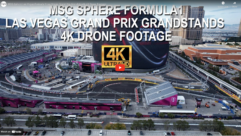
SVC Podcast – Show Notes – Show 134-1:
In this edition of the SVC Podcast, SVC Contributing Editor Bennett Liles talks with Keith Hanak, Executive Vice President of AV Solutions for Panasonic Enterprise Solutions Company, about the installation of new video display screens at the Indianapolis Motor Speedway. The screens provide much more than just race video but also show tire pressure, speed, lap number and other information.
Links of interest:
- Panasonic Enterprise Solutions Company
- The Indianapolis Motor Speedway
- Panasonic Pagoda where the control center is located
Download Podcast Here:
https://s3.amazonaws.com/nb-svc/public/public/134-1_Panasonic_Indy_500_1…
From Sound & Video Contractor Magazine, this is the SVC Podcast with Keith Hanak, Executive Vice President of AV Solutions for Panasonic Enterprise Solutions Company North America. Show notes for the podcast are available on the web site of Sound & Video Contractor Magazine at svconline.com.
The races at Indianapolis Motor Speedway have always been exciting but now they’re taking on a whole new dimension with a massive video display upgrade from Panasonic Enterprise Solutions Company. Vice President Keith Hanak is here to tell us about how it all got done. That’s coming up next on the SVC Podcast.
Keith, it’s a pleasure to have you with us on the SVC Podcast from Panasonic Enterprise Solutions Company North America where you’re the Executive Vice President for AV Solutions. It sounds to me as though you had to come up with a lot of solutions just for this one big project.
Yeah, absolutely. And it’s a great position to have and we’ve had a lot of great customers and great projects. It makes coming to work pretty easy.
What have you got going on at Panasonic Enterprise Solutions Company other than the Indy Motor Speedway video upgrade?
We’ve been very fortunate. We had a really big year with some marquee projects. We actually put in the Guinness World Record largest video board at Texas Motor Speedway that had been completed in March of last year. Then in April we finished Churchill Downs, which is the world’s first 4K outdoor video board. And as we rolled into summer we did the Philadelphia Eagles, renovated their facility and stadium. We’re very proud of that. There were several other projects in between. We completed the NASDAQ also in the summer and then we got the start in late summer and the fall we started working with Indianapolis Motor Speedway. [Timestamp: 2:01]
And that’s not exactly a low profile place. So what was the Indianapolis Motor Speedway looking for in this upgrade project?
They actually wanted to improve the fan experience and they wanted to do that while maintaining a lot of the tradition that exists. I think this year will be the 99th running of the Indy Motor Speedway. There’s a lot of tradition. The facility is spectacular. They have somewhere between 250,0000 and 350,0000 guests that show up just for the Indy 500 and their goal was to have 100 percent of them have an improved fan engagement experience; and that’s pretty difficult to do given the size of the facility at Indy Motor Speedway. So ultimately what we did was put together a distributed solution of displays with more than 10 million pixels. There’s 20 displays – not including the pylon sign which we integrated last summer – and we needed to do all of that in a relatively short period of time; about five months. Great group of folks. Doug Boles and the team at Indy was just fantastic to work with. We had a great time integrating it. We’re at the tail end and it’s show time in two or three days. So that’s where we are. [Timestamp: 3:21]
Yeah, as we’re recording this it’s just before the big race. Now they already had display boards. Did you replace the old ones or just add to them?
We actually replaced almost everything that was there and we added some new ones that didn’t exist. Many of them grew in size four times larger than they were just in terms of physical size, and pixel pitch in some cases was increased by as much as two-and-a-half times. So they went bigger and they went brighter and they went with a tighter pixel pitch resolution. [Timestamp: 3:53]
Yeah, I was going to ask you about the difference in resolution between the old and the new but it sounds like they have a whole new experience from these new boards just in the clarity of the pictures alone.
Absolutely. And I think what’s really great about how they’ve implemented the solution – it’s complicated because of all the various locations and where they have fans. I think the goal there was to get 100 percent coverage. I think based on our rough calculations we got about 98 percent of the fans are going to have a clearer, brighter, better view of the race events. [Timestamp: 4:25]
Okay. Now I was sort of curious as to how you get the video signals conveyed to all the screens. In what video format is the signal input to each of the big screens?
The actual video format that goes up to the displays is actually DBI. So that’s what’s input to the video processor that’s located at the display. That’s actually sent via fiber to each of the screens. So we’ve got the fiber that was already in place. We had to modify and upgrade the converters at either end in order to facilitate that. And we had to upgrade, obviously, the control room in order to be able to output the resolutions that were actually hitting the screens. [Timestamp: 5:07]
And of course they’re not just looking at video of cars going around. That’s the usual race video experience but they have a lot more things going on with these displays. They can see tire pressure, speed, lap counters and all of that. How is all of that information gathered and transmitted to the new screens?
We actually have a real-time 3D rendering engine that collects the data and collectively with the good folks at Indy Motor Speedway we actually went through and created looks that they would like to see. So we created dashboards and other things that actually kind of put the fan into the driver’s seat, so to speak, and we’re able to convey a lot of information graphically and otherwise. A lot of data, though, because you have sets of data from each of the drivers plus at Indy, of course, everything there, because they support Indy car events and motocross as well as NASCAR, the number of data streams from various sources that we’re dealing with and displaying is really a tremendous number. And so we know we’re ready to go for the Indy event, but there will be some additional looks and things that we’re going to create over time as more events take place at the track. [Timestamp: 6:21]
And this place has grown considerably not only in the high profile image it has but also in its capabilities with broadcast and all the electronics. So where does all that come together? Where is the control point located and what other capabilities does it have as far as doing broadcast, video playback and all that?
Everything’s located in the pagoda tower and what a great place for it, right? That’s a beautiful facility; very iconic. So it’s got not only the capabilities that they have in house with a lot of the new graphics and data feeds that they’ve created, but they’ve also got the ability to tie into many of the feeds that are coming from all the broadcast sources as well as advertising graphics, as well as the potential to do social media and other fan engagement activities. So there’s quite a show going on and there’s a lot happening behind the scenes to create the show for the audience and fans at the race. [Timestamp: 7:15]
Oh, just the amount that’s going on behind the scenes with RF coordination and all of that it’s just amazing how it can all be brought together and all happen just like dominos falling in the right direction. Now all of these displays are out in the weather, they’re out in the sun, so how do you control the internal temperature? They must get fairly warm inside.
The technology has improved dramatically over time so the screens are actually an IP rating of IP65 in front and IP54 from the rear which basically means very well protected from the elements. There are fans and other things that are thermostatically controlled based on the temperature inside those cabinets and those things operate and feed some of the data back to the control room so we get a sense of how everything is performing and diagnostic warnings in terms of the performance of the systems. So if we see that something’s acting up a lot of times we’ll be able to address it before it becomes apparent to the fans. [Timestamp: 8:11]
Ah, remote control. It’s great. Well, I really appreciate your giving us the layout on this massive video upgrade and in Part 2 we’ll get into some of the details of the installation process itself. Keith Hanak, Executive Vice President of AV Solutions for Panasonic Enterprise Solutions Company North America and the new video display upgrades at Indianapolis Motor Speedway. Thanks for being with us, Keith.
Thanks for having us.
Thank you for being here with us for the SVC Podcast with Keith Hanak. Show notes are available on the website of Sound & Video Contractor Magazine at svconline.com. Join us for Part 2 when Keith will take us through the details of the installation. That’s on the next SVC Podcast.










